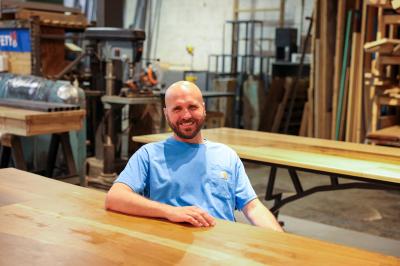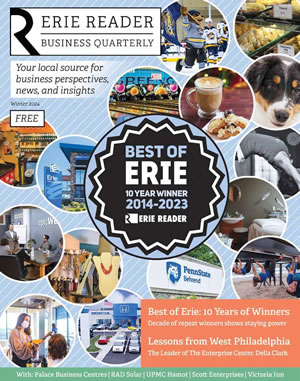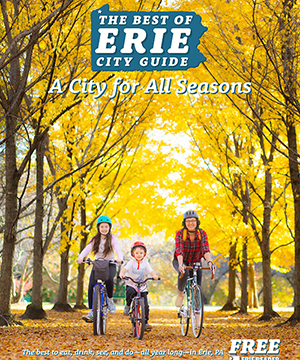Gem City Style: 40 Under 40 Catch-up
A conversation with Brad Triana of Both Studios
Stepping into Brad Triana's expansive workshop in Erie's Little Italy, you quickly realize this isn't just a woodshop – it's what he calls a "test kitchen" for creativity. "My life revolves around making objects," he says, and over the past decade, that devotion has earned him a reputation as one of Erie's master craftsmen. His goal? To create a space that's always "conducive to growth and exploration."
Part of Erie's 40 Under 40 class back in 2014, Triana reflects on the whirlwind since: "I had to look back at that issue and kind of see where I was at and really take account of what's happened since then," he muses, scrolling through his camera roll to chronicle the evolution of his craft.
His business Both Studios began humbly in his two-car garage shortly after that 40 Under 40 recognition. "I got my first commission, realized that I like to make really large objects, and my garage was not able to support what I wanted to do," he recalls. Both Studios, he explains, is a "fabrication shop that produces custom furniture by commission," with a mission to "assist both residential and commercial clients in discovering and making heirloom-quality objects," incorporating both wood and metal. Like many things in Erie, a word-of-mouth connection led him to his current space at the Shop at 19th and Chestnut, where he's been crafting for about 10 years, maintaining a "very flexible space to accommodate a wide variety of projects."
Woodworking has always been in Brad's blood, with both his grandfather and father having woodshops in their basements. While they never pursued it professionally, the craft always intrigued him. Growing up as a "big Tim Taylor and Norm Abrams fan," his love of tools runs deep. The pivotal moment to pursue it as a career came at the end of his undergrad work, when a professor encouraged him to forgo teaching and dive into woodworking. His father's adage, "with the right tools, you can make anything," became a guiding principle, shaping his career around the pursuit of those very tools.
Before Both Studios, Brad explored various paths. He tried substitute teaching, worked at a pipe organ factory in town, and even took photos for the Erie Reader. He briefly taught at Edinboro University, covering for his professor. It was during his time at the organ factory that he landed his first commission, solidifying his desire to focus on custom work.
Brad's design aesthetic is best described as "minimalist meets warmth." Rather than describe his work, he prefers to show it. "I'm not really a talker as much as I just like to cut straight to the point," he admits, finding that showing images immediately sparks a conversation. His process often begins with "a rough sketch and allows flexibility in discovering the final product." He loves "letting the materials talk to me and inform the design."
His current inspiration comes from an unexpected source: bridge building and design. Having recently delved into welding, many of his pieces feature steel bases, and he looks to different bridge designs to "cantilever the tops." This approach helps him "think outside the box" and makes his creations "less chunky, more streamlined." He also emphasizes that "the most interesting and unexpected solutions come about through limited materials." He works to incorporate other elements to complete a thought, finding that "it is through this process that true creativity flourishes." Sometimes, he even makes "scale modes" for clients, finding it "fun to see a large conference table begin sized for a cat and develop into its full-scale form."
Every project, Brad says, presents a creative challenge. A monumental undertaking was a 33-foot picture frame commissioned by the Jefferson Educational Society, built to house (fellow 40 Under 40 alum) Michael Hinman's 30-foot-wide, 7-foot-tall painting, The Agora. Having never worked on such a large scale, it taught him that he enjoys "making large scale objects that take weeks or months." More profoundly, it highlighted "the importance of friends and the community in making larger scale projects," as he often needs "an extra set of hands, or, you know, 10 extra sets of hands."
In an increasingly digital world, working with his hands holds deep meaning for Brad. He sees the rise of "throwaway culture," driven by quick and cheap production, as an opportunity for artisans like himself. He laments how "almost everything around us anymore is either made poorly or intended to fail," but sees opportunity in that for makers like himself: "While that is depressing, it opens up a lot of opportunities for people like me to show clients other, more sustainable ways of making." He believes "people have much more of a connection to things like wood and steel, as opposed to sawdust and glue." He emphasizes, "Fewer objects. Higher quality. Somewhere along the way, we stopped learning how to care for the things we own." Furthermore, "despite how well something is made, nothing is more important than caring for and maintaining the things you have."
Erie, the city and its community, has profoundly shaped his business philosophy. Brad, ever the optimist, focuses on the positive. He's "always honored that people will seek me out to help them solve their design or fabrication ideas, problems, whatever they be." The trust clients place in him to create something for their living or business spaces, something they interact with daily, is a constant source of gratitude. He finds immense reward when clients express a desire for pieces that can be passed down through generations. "It's always awesome when they come to me and say, 'you know, I'd like you to make something that I can give to my grandchildren,'" he shares, emphasizing the deep meaning behind such commissions, especially when clients bring their own materials to incorporate. The power of word-of-mouth in Erie, he admits, is consistently surprising.
So, what's next for Both Studios? Brad is enthusiastically working on a treehouse for his two children. He considers them his "favorite clients" because they "really helped teach me a lot about being aware of your environment, making things safe, stable that can last and hold up to the elements." The treehouse project holds personal significance, connecting to a family tradition – his grandfather, a woodworker, lived in a treehouse as a child, and later built one for Brad and his brothers. Building one for his own children has been a long-held dream.
One of his biggest challenges, he admits, is "finding enough time in the day to do the things I love" and "being torn between spending time with my family and creating." Yet, the "most rewarding times are when the two align," as he loves "spending time in my shop with my children and watching them play with materials and create on their own."
When asked about his personal style, Brad offers a humble, yet profound, perspective. "I don't want people to see me. I want them to see what I made, what I do." He draws a parallel to his passion for drumming, wherein the drummer's contributions to the band (in his case, Fox Grotto) are felt more than seen. For Brad, his life, whether in woodworking or drumming, is "all repetition," a slow, dedicated process of "building a skill up." The core philosophy is simple: "the more time and effort you put it in, the better the end product." And through his enduring work at Both Studios, Brad Triana continues to demonstrate the beautiful outcomes of that dedication.
For more information on Brad Triana and Both Studios, visit bothstudios.com
Gem City Style is a monthly column featuring an intimate Q&A with someone making a creative impact in Erie. If you or someone you know would make a good fit for a future Gem City Style, email jessica@eriereader.com





